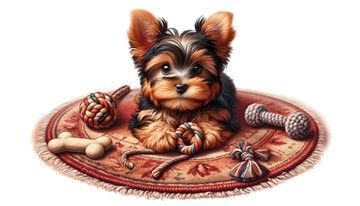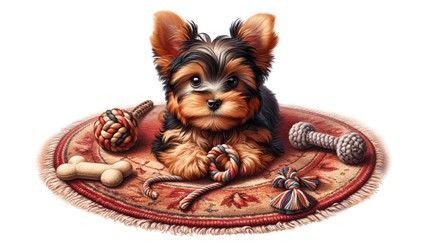Yorkshire Terrier Puppy Teething
Overview
All canines go through a teething phase, when their deciduous teeth (aka milk or baby teeth) gradually fall out and are replaced by erupting adult teeth. During this time, a Yorkie puppy's gums can be very sore and itchy. This often causes intense chewing urges to sooth the discomfort. Without properly addressing this, a puppy may rip, gnaw, shred or chew on anything they can get their little mouths on.
This article covers the age that Yorkshire Terrier puppies teethe, signs of teething, how to puppy-proof your home from a pup's sharp teeth while keeping them safe, and the steps you can take to help your little guy or gal satisfy their chewing urges via effective teething toys.
Please note: YorkieInfoCenter is reader-supported, and some of the product suggestions on this page are affiliate links. As an Amazon Associate we earn from qualifying purchases. This is at no extra cost to you and helps us continue providing free, high-quality information.
The Age that Yorkshire Terrier Puppies Start Teething
Yorkshire Terrier puppies start teething around 3 to 4 months of age, with this transition typically completing by the 9-month mark, though it can extend up to their first year for some. During this period, they will lose their 28 deciduous teeth, and 42 adult teeth will replace these. The sequence of teething and the function and count of each type of adult tooth are as follows:
- Incisors: The first to emerge around 4 months of age, incisors are used for cutting and nibbling food. Yorkshire Terriers have 12 incisors in total, with 6 located on both the upper and lower jaws.
- Canines: Following the incisors, the canine teeth appear around 5 months of age. These four teeth (two on the top and two on the bottom) are crucial for tearing food and are essential to the dog's defense mechanism.
- Premolars: After the canines, the premolars start to come in. By 5 to 6 months, premolars, used for tearing and grinding food, begin to emerge. Yorkshire Terriers have 16 premolars, with 8 on each side of the mouth, both upper and lower.
- Molars: The last to appear are the molars, which emerge around 6 months of age. Molars are vital for grinding food and facilitating digestion. Yorkshire Terriers have 10 molars, with 4 on the top jaw and 6 on the lower.
Teething is typically complete by 9 months old, with all adult teeth in place. During regular wellness checks, the vet will assess that the teething process is proceeding as expected and will address any dental issues that may arise, such as misalignment or retained baby teeth (more ahead). Proper at-home dental care starting at puppyhood can help prevent future dental problems and contribute to the overall health and well-being of your little guy or gal.
Signs of Teething
Teething is a significant developmental stage for puppies, including Yorkshire Terriers, and comes with various signs that indicate your puppy is experiencing this natural process. Recognizing these signs can help you provide the appropriate care and comfort to your puppy during this sometimes uncomfortable phase. Here are the main signs of teething in puppies:
- Increased Chewing and Biting: Pups may chew more frequently or bite on objects (or even people) to relieve the sensation.
- Drooling: Some puppies may drool more than usual.
- Whining or Fussiness: The discomfort or pain from teething can make puppies more vocal or fussy.
- Swollen, Sensitive Gums: Gums may appear redder, swollen, or feel warmer.
- Bleeding Gums: It's not uncommon to see small spots of blood on your puppy's toys or where they chew.
- Missing Teeth: You may find small teeth around your home, though in many cases a pup will swallow the tooth while eating. You will notice gaps in their mouth where new teeth will soon emerge.
- Decreased Appetite: Some puppies might eat less during teething due to gum soreness. Softening their food with warmed low-sodium chicken or beef broth can help encourage eating.
- Rubbing Face: Puppies might rub their face against furniture or the floor to relieve discomfort in their gums.
- Odd Odor from Mouth: You might detect a peculiar smell from your puppy's mouth, similar to spoiled milk, due to mixture of saliva and bleeding gums.
Retained Milk Teeth
Retained baby teeth are a common issue that may arise during the teething process of Yorkshire Terriers. This condition, sometimes referred to as a "double row of teeth," occurs when the deciduous (baby) teeth do not fall out as the permanent adult teeth emerge. This can lead to the teeth overcrowding in the mouth and misalignment of the new teeth, potentially causing dental problems such as gum disease and/or tooth decay due to difficulty in cleaning.
Veterinarians often recommend extracting retained baby teeth to safeguard oral health, ensuring adult teeth emerge correctly and prevent overcrowding and future dental problems. This procedure is usually straightforward, as the milk teeth have small and shallow roots, but does often require sedation or general anesthesia. Be sure the vet conducts rigorous safety protocols, including pre-anesthetic evaluations, vital signs monitoring and the use of a warming blanket, to minimize risks.
How to Puppy-proof your Home from a Teething Puppy
Puppy-proofing your home for a teething Yorkshire Terrier is essential to keep both your puppy and belongings safe. With their small size and curious nature, Yorkshire Terriers require specific considerations during this phase. Here’s a practical guide to creating a safe environment for your teething pup:
Secure Loose Items: Yorkie puppies are tiny and can get into tight spaces. Ensure that small objects, such as jewelry, coins, and doodads, are out of reach to prevent choking hazards.
Protect Your Furniture: Cover the legs of furniture with protective materials or apply bitter apple spray to deter chewing. Teething puppies tend to gnaw on anything, including table legs or whatever they can reach, to relieve gum discomfort.
Offer Plenty of Chew Toys: Provide a good variety of chew toys specifically designed for teething puppies. These toys can soothe their gums, satisfy their chewing urges and keep them engaged, diverting their attention away from your valuables (See 'Effective Teething Toys' below).
Electrical Cord Safety: Tuck electrical cords out of reach or use cord protectors. Pups may chew on cords, posing a risk of electric shock or ingestion of dangerous materials.
Secure Trash Cans and Hazardous Materials: Ensure small trash cans are securely closed or stored away. Keep cleaning supplies, medications, and other hazardous materials in locked cabinets.
Create a Puppy-Safe Zone: Designate a safe area in your home where your puppy can play and rest without getting into trouble. This could be a puppy-proofed room or a canine playpen stocked with toys and a comfortable bed to rest on.
Supervise Outdoor Time: When your Yorkshire Terrier is outside, keep an eye on them to prevent chewing on potentially toxic plants or other unsafe elements.
Keep Doors Closed: Ensure doors to rooms with hazards or valuable items are kept closed. Installing baby gates can also help restrict your puppy’s access to certain areas of the house.
Check for Small Spaces: Yorkshire Terriers can fit into small gaps, so block off spaces behind appliances or furniture where they might get stuck or find something dangerous to chew.
The Most Effective Teething Toys for a Yorkshire Terrier Puppy
Finding the right teething toys for Yorkshire Terriers can be challenging, as many are tailored for larger breeds, which can be too big even for an adult Yorkie. It's essential to select toys specifically designed for toy breeds or those available in extra-small or small sizes so that it fits into a tiny pup's mouth.
Toys featuring nubs are particularly beneficial as they can soothe itchy gums effectively. Additionally, twisted rope or durable fabric toys are excellent for teething puppies. For added relief, you can dampen a rope or cloth toy, freeze it for about an hour, and then give it to your puppy; the chill from the toy helps alleviate teething discomfort.
Let's look at our top picks for toys that will satisfy strong chewing urges and soothe itchy gums:
We're surprised that this is marketed for all pups in general because larger dogs will rip these to shreds, and its size is great for toy breeds like the Yorkshire Terrier. We love this set because it comes with 3 different toys: a twisted rope, a fabric toy with small flaps, and a rubber chew with knotted tassels. These are great as is but are designed to be wet and then frozen, which can really help with teething discomfort.
This is another great find: a set of teething toys small enough to be effective for Yorkshire Terrier puppies. This 4-pack has helpful options: a rope ball, a ball with teeth (to hold dry kibble; this works great as an incentive), a textured ball (the nubs are great for itchy gums) with a small squeaker, and a softer foam ball for sensitive mouths.
This brand offers some entertaining interactive toys, but many are sized for adult Yorkies. Luckily, there is this extra-small (6-inch) option that's soft and comforting with a small squeaker inside it. This is the type of teething toy a pup will carry around with them, taking turns cuddling with and chewing on.
Teething Toy Tips
If a Teething Puppy Nips at or Likes to Chew on Your Hands
When your adorable teething puppy starts nipping at or chewing on your hands or fingers, it's a sign they're seeking relief from the discomfort of new teeth coming in. While it's a natural behavior, it's important to guide your Yorkie towards more appropriate chewing habits. Here's a step-by-step guide to help redirect this behavior, ensuring your interactions remain positive and your puppy grows into a well-mannered adult dog.
Step 1: Understand the Behavior: Recognize that nipping and chewing are part of your puppy's exploration of the world and teething relief. It's not aggressive behavior but a call for help with a pup's discomfort.
Step 2: Provide Appropriate Chew Toys: Ensure your puppy has a good variety of chew toys. Toys designed for teething puppies can offer the relief they seek and distract them from chewing on your hands. Rotate the toys to keep their interest (refer back to 'Effective Teething Toys').
Step 3: Redirect Immediately: When your puppy begins to nip or chew on your hands, say a firm "no" or "ouch" to signal that it's unacceptable. Immediately offer them a chew toy instead. This teaches them what is appropriate to chew on.
Step 4: Use Positive Reinforcement: Praise your puppy or offer training treats when they chew on their toys instead of your fingers or hands. Positive reinforcement encourages good behavior, reinforcing that they've made the right choice.
Step 5: Implement a Time-out Strategy: If the nipping persists, use a time-out strategy. Gently remove yourself from the situation or place the puppy in a safe, puppy-proofed area for a short cool-down period. This helps them learn that nipping leads to the end of playtime.
Step 6: Engage in Positive Play: Use toys to engage your puppy in non-contact types of play, such as fetch. This can satisfy their play instinct without encouraging them to chew on you.
Step 7: Be Patient and Consistent: Remember, teaching takes time and patience. Consistency in your responses to unwanted nipping is key to successfully training your puppy.
By understanding and addressing the reason behind the nipping and providing suitable alternatives, you can help your little guy or gal navigate the teething phase without developing bad habits.
More Articles:
Yorkshire Terrier Puppy Care Tips - This is a great summary of the most important care tips for Yorkies age 1 and under, for optimal care and well-being. Includes helpful, concise FAQ.
Do and Don't List for Yorkies - A super-helpful concise guide on the most important do's and the most vital don'ts for this amazing toy breed. How many are you following?




